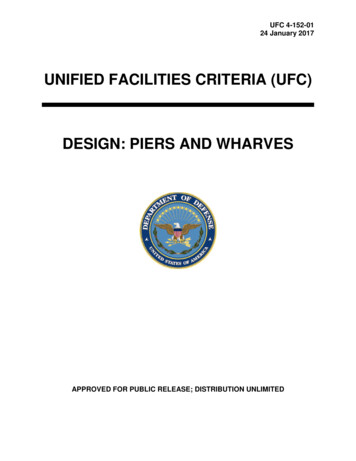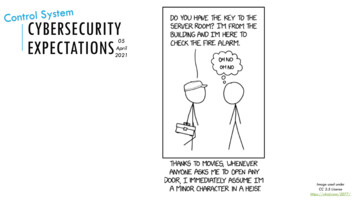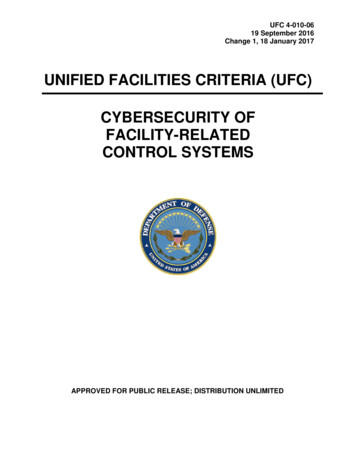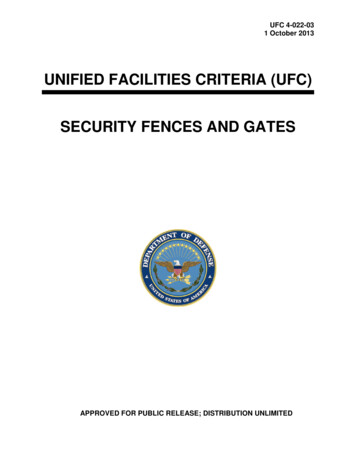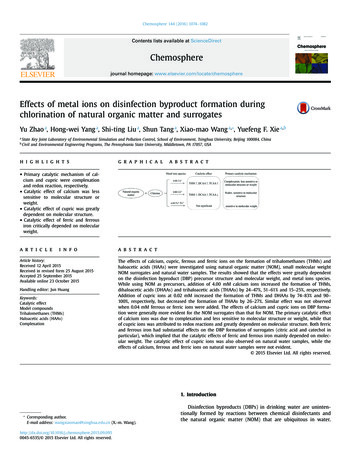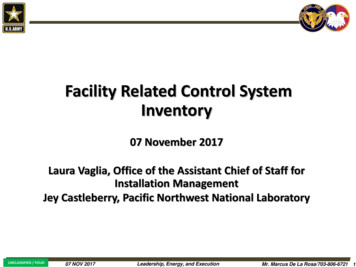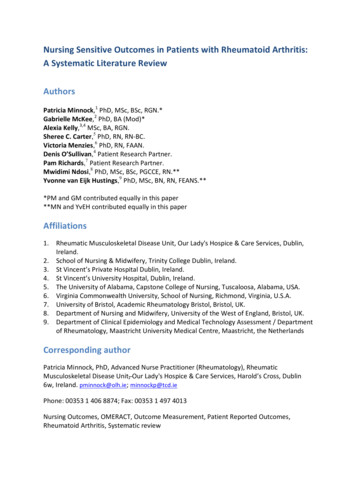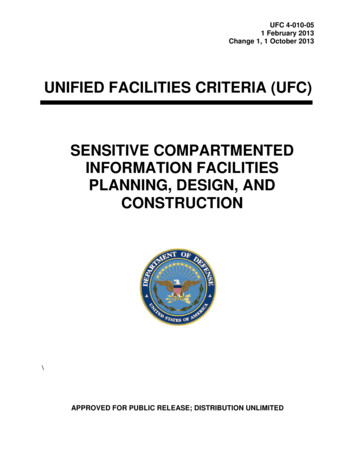
Transcription
UFC 4-010-051 February 2013Change 1, 1 October 2013UNIFIED FACILITIES CRITERIA (UFC)SENSITIVE COMPARTMENTEDINFORMATION FACILITIESPLANNING, DESIGN, ANDCONSTRUCTION\APPROVED FOR PUBLIC RELEASE; DISTRIBUTION UNLIMITED
UFC 4-010-051 February 2013Change 1, 1 October 2013UNIFIED FACILITIES CRITERIA (UFC)SENSITIVE COMPARTMENTED INFORMATION FACILITIES PLANNING, DESIGN,AND CONSTRUCTIONAny copyrighted material included in this UFC is identified at its point of use.Use of the copyrighted material apart from this UFC must have the permission of thecopyright holder.U.S. ARMY CORPS OF ENGINEERSNAVAL FACILITIES ENGINEERING COMMAND (Preparing Activity)AIR FORCE CIVIL ENGINEER CENTERRecord of Changes (changes are indicated by \1\ . /1/)Change No.1Date1 Oct 2013LocationAdded paragraphs 3-5.6.4, 3-5.6.1 and 3-5.14Added Figure 3-3Modified paragraphs 1-4, 1-12, 1-13, 3-5.4.5, 3-5.6, 35.6.4, 3-5.6.5.1, 3-5.6.10, 3-5.7, 3-5.7.1, 3-5.8.1, 35.8.2, 3-5.8.3, 3-5.9, 3-5.9.1, 3-5.10, 3-5.12.1, 3-5.12.3,3-5.12.3.2 3-5.12.3.3, and 3-5.13Modified Figure 3-10Modified References
UFC 4-010-051 February 2013Change 1, 1 October 2013FOREWORDThe Unified Facilities Criteria (UFC) system is prescribed by MIL-STD 3007 and providesplanning, design, construction, sustainment, restoration, and modernization criteria, and appliesto the Military Departments, the Defense Agencies, and the DoD Field Activities in accordancewith USD (AT&L) Memorandum dated 29 May 2002. UFC will be used for all DoD projects andwork for other customers where appropriate. All construction outside of the United States isalso governed by Status of Forces Agreements (SOFA), Host Nation Funded ConstructionAgreements (HNFA), and in some instances, Bilateral Infrastructure Agreements (BIA.)Therefore, the acquisition team must ensure compliance with the most stringent of the UFC, theSOFA, the HNFA, and the BIA, as applicable.UFC are living documents and will be periodically reviewed, updated, and made available tousers as part of the Services’ responsibility for providing technical criteria for militaryconstruction. Headquarters, U.S. Army Corps of Engineers (HQUSACE), Naval FacilitiesEngineering Command (NAVFAC), and Air Force Civil Engineer Center (AFCEC) areresponsible for administration of the UFC system. Defense agencies should contact thepreparing service for document interpretation and improvements. Technical content of UFC isthe responsibility of the cognizant DoD working group. Recommended changes with supportingrationale should be sent to the respective service proponent office by the following electronicform: Criteria Change Request. The form is also accessible from the Internet sites listed below.UFC are effective upon issuance and are distributed only in electronic media from the followingsource: Whole Building Design Guide web site http://dod.wbdg.org/.Refer to UFC 1-200-01, General Building Requirements, for implementation of new issuanceson projects.AUTHORIZED BY:JAMES C. DALTON, P.E.JOSEPH E. GOTT, P.E.Chief, Engineering and ConstructionU.S. Army Corps of EngineersChief EngineerNaval Facilities Engineering CommandSCOTT HARTFORD, Colonel, USAF, P.E.Acting DirectorMICHAEL McANDREWFacilities Engineering Center of ExcellenceAF Civil Engineer CenterOffice of the Deputy Under Secretary of Defense(Installations and Environment)Director, Facilities Investment and Management
UFC 4-010-051 February 2013Change 1, 1 October 2013UNIFIED FACILITIES CRITERIA (UFC)REVISION DOCUMENT SUMMARY SHEETDocument: UFC 4-010-05, Sensitive Compartmented Information Facilities Planning,Design, and Construction, with Change 1Superseding: UFC 4-010-05, Sensitive Compartmented Information FacilitiesPlanning, Design, and ConstructionDescription: This change includes updates due to DoDM 5105.21, IC Tech Spec-forICD/ICS 705 and added clarification on TEMPEST mitigation.Reasons for Document:Director of National intelligence issued policy for the planning, design, and constructionof SCIF. There was no UFC document that prescribed facility criteria for SCIF. ThisUFC provides unified criteria for the planning, design, and construction of SensitiveCompartmented Information Facilities (SCIF). This document is one of a series of security engineering criteria documents coveringphysical countermeasures for the current threat environment. The design of physical security measures is a specialized technical area that doesnot fall in the normal skill record and resume of commanders, architects, engineers,and project managers. This document provides guidance to those parties taskedwith implementing existing and emerging physical protection system requirementsfor SCIF. This document provides a unified approach for physical security measures for SCIF.Impact: Implementation of Director of National Intelligence (DNI) policy for SCIF may havesignificant cost impacts for SCIF constructed overseas. This is primarily due to thesecurity requirements for personnel and companies designing and constructing SCIFoutside the United States and the access control measures that may have to beimplemented during construction.Unification IssuesThere are no unification issues.
UFC 4-010-051 February 2013Change 1, 1 October 2013TABLE OF CONTENTSCHAPTER 1 INTRODUCTION . 11-1BACKGROUND. . 11-2PURPOSE. . 11-3APPLICABILITY. . 11-4REFERENCES. . 11-5GLOSSARY. . 11-6POLICY. . 11-7IMPLEMENTATION. 21-8GENERAL BUILDING REQUIREMENTS. . 21-9RISK MANAGEMENT. . 21-9.1Security in Depth (SID). . 31-10SCIF CLASSIFICATIONS. . 41-10.1Secure Working Area (SWA). . 41-10.2Temporary Secure Working Area (TSWA). . 41-10.3Temporary SCIF. . 41-10.4Closed Storage. . 41-10.5Open Storage. . 41-10.6Continuous Operation. . 41-11SCIF SECURITY REQUIREMENTS. . 41-12CONSTRUCTION SECURITY PLAN (CSP). . 41-13INFORMATION SECURITY. . 51-14SCIF DESIGN SECURITY. . 51-15SCIF CONSTRUCTION SECURITY. . 51-15.1SCIF Within the United States. . 61-15.2SCIF Outside the United States. . 61-16SCIF ACCREDITATION. . 61-16.1Accreditation Process. . 61-16.2Fixed Facility Checklist (FFC). . 71-16.3TEMPEST Review. . 71-171-17.1HISTORIC PRESERVATION COMPLIANCE. . 7Security and Stewardship. . 7i
UFC 4-010-051 February 2013Change 1, 1 October 20131-17.2Compliance with Laws. . 71-17.3Compliance with DoD Standards. . 81-18SECURITY ENGINEERING UFC SERIES. . 81-18.1DoD Minimum Antiterrorism Standards for Buildings. . 81-18.2DoD Security Engineering Facilities Planning Manual. . 81-18.3DoD Security Engineering Facilities Design Manual. . 91-18.4Security Engineering Support Manuals. . 91-18.5Security Engineering UFC Application. . 9CHAPTER 2 PLANNING . 112-1ESTABLISH PLANNING REQUIREMENTS. . 112-1.1Minimum and Enhanced Security. . 112-1.2Planning Team. 112-2PLANNING DOCUMENTATION. . 122-2.1Configuration of SCIF Spaces. . 122-2.2SCIF and Historic Preservation. 122-2.3Construction Security. . 122-2.4Project Documentation. . 12CHAPTER 3 DESIGN . 153-1VALIDATE PLANNING REQUIREMENTS. . 153-2MINIMUM AND ENHANCED SECURITY. 153-3DESIGN APPROVAL. . 153-4GENERAL DESIGN STRATEGY. . 153-4.1Configuration of SCIF Spaces. . 163-4.2SCIF Perimeter. . 163-4.3Intrusion Detection System. . 163-4.4Sound Attenuation. . 173-4.5Electronic Emanations - TEMPEST. . 173-5SPECIFIC DESIGN STRATEGY. . 173-5.1Adjacent Space. 183-5.2Vestibule. . 183-5.3Perimeter Construction. . 183-5.4Perimeter/Compartmented Areas Walls. . 18ii
UFC 4-010-051 February 2013Change 1, 1 October 20133-5.5Ceiling and Floors. . 213-5.6Perimeter Doors. 213-5.7Windows. . 243-5.8Perimeter Penetrations. . 253-5.9Vents, Ducts, and Pipes. 263-5.10Access Port. 273-5.11Flashing or Rotating Light. . 273-5.12Duress Alarm. . 273-5.13Electronic Security System (ESS). 293-5.14Telecommunication Cabling System. . 323-5.15TEMPEST Countermeasures. . 32CHAPTER 4 CONSTRUCTION . 354-1DESIGN APPROVAL. . 374-2CONSTRUCTION SECURITY. . 374-3ACCREDITATION PROCESS. 374-4INSPECTIONS. . 374-5PHOTOGRAPHIC CONSTRUCTION SURVEILLANCE RECORD. . 39APPENDIX A REFERENCES . 41APPENDIX B GLOSSARY . 45APPENDIX C MINIMUM CONSTRUCTION . 49FIGURESFigure 1-1 Security-in-Depth . 3Figure 1-2 SCIF Drawings . 5Figure 1-3 Security Engineering UFC Application . 10Figure 3-1 Six Sided Approach . 16Figure 3-2 Wall Finish . 19Figure 3-3 Furred Out Wall for Utilities . 21Figure 3-4 Tamper Resistant Hinges. 23Figure 3-5 Emergency Exit Doors . 24Figure 3-6 Duct Penetrations . 26Figure 3-7 Sealing Penetrations . 28Figure 3-8 Bars on Penetration . 28Figure 3-9 Access Port . 28Figure 3-10 Notional IDS Layout . 30TABLESTable C-1 Minimum SCIF Wall Construction and Alarm. 49iii
UFC 4-010-051 February 2013Change 1, 1 October 2013This Page Intentionally Left Blankiv
UFC 4-010-051 February 2013Change 1, 1 October 2013CHAPTER 1 INTRODUCTION1-1BACKGROUND.Sensitive Compartmented Information (SCI) is classified Confidential, Secret or TopSecret information that is derived from intelligence sources, methods or analyticalprocesses which is required to be handled within formal control systems established bythe Director of National Intelligence. Sensitive Compartmented Information (SCI) canonly be handled, processed, discussed, or stored in an accredited SensitiveCompartmented Information Facilities (SCIF).Sensitive Compartmented Information Facilities (SCIF) are accredited areas, room(s) orbuilding(s) where Sensitive Compartmented Information (SCI), is stored, used,processed or discussed. SCIF are only required for SCI and not necessarily required forSecret or Top Secret information. When required, SCIF provide an operationalcapability that is critical to the supported command’s mission.1-2PURPOSE.Intelligence Community Directive (ICD) 705 established that all Intelligence Community(IC) SCIF comply with uniform IC physical and technical security requirements.Intelligence Community Standard (ICS) 705-1 and the IC Tech Spec-for ICD/ICS 705provide the physical and technical security standards for all SClF including existing andnew construction, and renovation projects. This UFC is intended to make planning,design and construction communities aware of the published policy and ensure timelyand appropriate implementation.1-3APPLICABILITY.This document provides planning and design criteria for DoD components andparticipating organizations. This document applies to all construction, renovation, andrepair projects for SCIF.1-4REFERENCES.Appendix A contains a list of references used in this document. The publication date ofthe code or standard is not included in this document. \1\ The most recent edition ofreferenced publications applies, unless otherwise specified. /1/1-5GLOSSARY.Appendix B contains acronyms, abbreviations, and terms.1-6POLICY.Director of Central Intelligence Directive (DCID) No. 6/9 was rescinded by the issuanceof ICD 705 by the Director of National Intelligence. ICD 705 replaces DCID No. 6/9 andall its annexes as the policy for SCIF. ICS 705-1 was issued by the Director of National1
UFC 4-010-051 February 2013Change 1, 1 October 2013Intelligence (DNI) on 17 September 2010. ICS 705-1 and the IC Tech Spec-for ICD/ICS705 provide the standards for the physical and technical security standards that apply toa SCIF, including existing, new construction, and renovation of SCIF. Refer to ICD 705,ICS 705-1, and IC Tech Spec-for ICD/ICS 705 for more information.DoDM 5200.01 is the primary document associated with SCIF administration. Themanual is composed of several volumes, each having its own purpose. It assignsresponsibilities and prescribes procedures for the implementation of Director of CentralIntelligence and Director of National Intelligence (DNI) policies for SCI.1-7IMPLEMENTATION.Intelligence Community (IC) elements shall fully implement ICS 705-1 and IC TechSpec-for ICD/ICS 705 within 180 days of signing. ICS 705-1 was signed on 17 Sep2010 and IC Tech Spec-for ICD/ICS 705 was signed on 5 May 2011. Facilities underconstruction or renovation as of the effective date of ICS 705-1 shall be required tomeet these standards or request a waiver to the standards. The Accrediting Official(AO) is responsible to request waiver approval.Each SCIF must be planned, programmed, designed, and constructed on a project byproject basis. Work closely with the supported command, designated Site SecurityManager (SSM), and the Certified TEMPEST Technical Authority (CTTA) to determinethe requirements for each SCIF.1-8GENERAL BUILDING REQUIREMENTS.UFC 1-200-01, "General Building Requirements", provides applicability of modelbuilding codes and government-unique criteria for typical design disciplines and buildingsystems, as well as for accessibility, antiterrorism, security, sustainability, and safety.Use this UFC in addition to UFC 1-200-01 and the UFCs and government criteriareferenced therein.1-9RISK MANAGEMENT.Per ICS 705-1, the AO must ensure the application of analytical risk management in theSCIF planning, design and construction. Analytical risk management is the process ofassessing threats against vulnerabilities and implementing security enhancements toprotect assets at an acceptable level of risk, and within acceptable cost.The CTTA will use a risk based approach outlined in CNSSI No. 7000 to determineapplicable countermeasures for each SCIF. Supported command will provide the CTTAwith a completed DNI TEMPEST Checklist for review. The TEMPEST Checklist isincluded in the IC Tech Spec-for ICD/ICS 705. Project Managers may need to providesite plans and building floor plans to assist CTTA in the determination of TEMPESTcountermeasures.2
UFC 4-010-051 February 2013Change 1, 1 October 20131-9.1Department of State (DoS) Security Environment Threat List (SETL).The SETL and its contents are classified information. The SETL reflects four categoriesof security threats for overseas locations. The AO will utilize the SETL category todetermine security requirements for locations outside the United States.1-9.2Security in Depth (SID).SID is desired for all SCIF and required for all SCIF located outside the United States.SID is a multilayered approach, which effectively employs human and other physicalsecurity measures throughout the installation or facility to create a layered defenseagainst potential threats. The intent of SID is to increase the possibility of detection ofpotential aggressors prior to compromising the SCI. The AO will assess the layers ofsecurity measures in place to determine if any security enhancements are required.The primary means to achieve SID include: Located on a Military installation or compound with a dedicated response force ofU.S. citizens or U.S. persons. Located within a building or fenced compound that employs access control. Office areas adjacent to or surrounding the SCIF are controlled and are protectedby alarm.Figure 1-1 Security-in-Depth3
UFC 4-010-051 February 2013Change 1, 1 October 20131-10SCIF CLASSIFICATIONS.SCIF are classified based on operational requirements. Per ICS 705-1, there are sixSCIF classifications.1-10.1Secure Working Area (SWA).Area where SCI is handled, discussed, and/or processed but not stored.1-10.2Temporary Secure Working Area (TSWA).Secure working area is SCIF that is used less than 40 hours per month.1-10.3Temporary SCIF.SCIF established for a limited time to meet tactical, emergency, or immediateoperational requirements.1-10.4Closed Storage.SCIF where SCI material is stored in GSA approved storage containers when not inuse. This includes documents, computer hard drives, and storage media.1-10.5Open Storage.SCIF in which SCI may be openly stored or processed.1-10.6Continuous Operation.SCIF which is staffed and operated 24/71-11SCIF SECURITY REQUIREMENTS.ICS 705-1 and IC Tech Spec-for ICD/ICS 705 provide the minimum and enhancedsecurity requirements. The minimum security requirements for a SCIF are based onclassification and location. To implement security enhancements above the minimum,the AO must evaluate the threat, SID and balance the enhancements with risk atacceptable cost.1-12CONSTRUCTION SECURITY PLAN (CSP).Per ICS 705-1, a Construction Security Plan (CSP) shall be developed by the SSM andapproved by the AO to address the application of security to the SCIF planning, design,and construction. \1\ /1/4
UFC 4-010-051 February 2013Change 1, 1 October 20131-13INFORMATION SECURITY.Per ICS 705-1, construction plans and all related documents shall be handled andprotected in accordance with the CSP. If classification guides dictate, plans and relateddocuments may require classification. DoDM 5105.21 Vol 2 states the facility’s location(complete address) and identity as a SCIF shall be protected at a minimum of FOROFFICIAL USE ONLY (FOUO). Drawings or diagrams identified as a SCIF may not beposted on an UNCLASSIFIED website or transmitted over the Internet without some type ofencryption. Therefore, do not identify SCIF locations on planning or constructiondocuments; see Figure 1-2. With SSM’s approval, areas may be identified as “SecureArea” or “Controlled Area”. Under no circumstances shall plans or diagrams that areidentified for SCI be sent or posted on unprotected information technology systems orInternet venue without encryption. Refer to DoDM 5200.01 \1\ /1/ and the Service’srelated policy documents for guidance on the handling of classified information.Figure 1-2 SCIF Drawings1-14SCIF DESIGN SECURITY.Per ICS 705-1, design of SCIF shall be performed by U.S. companies using U.S.citizens or U.S. persons. AO shall ensure mitigations are implemented when using nonU.S. citizens and these mitigations shall be documented in the CSP.U.S. Person is defined as an individual who has been lawfully admitted for permanentresidence as defined in 8 U.S.C. 1101(a)(20) or who is a protected individual as definedby Title 8 U.S.C. 1324b (a)(3), and able to provide two forms of identification listed onDepartment of Homeland Security Form I-9, Employment Eligibility Verification.1-15SCIF CONSTRUCTION SECURITY.Per ICS 705-1, construction security requirements are documented in the CSP.Depending on the location of the SCIF, the AO may impose procedures for the5
UFC 4-010-051 February 2013Change 1, 1 October 2013procurement, shipping, and storing of construction materials at the site. Theseprocedures must be documented in the CSP.1-15.1SCIF Within the United States.General construction of SCIF shall be performed by U.S. companies using U.S. citizensor U.S. persons. The AO shall ensure mitigations are implemented when using nonU.S. citizens. These mitigations shall be documented in the CSP.Intrusion Detection System (IDS) installation and testing shall be performed by U.S.companies using U.S. citizens.1-15.2SCIF Outside the United States.General SCIF construction shall be performed using U.S. companies using U.S.citizens. 1-16On military facilities, the AO may authorize foreign national citizens or companiesto perform general construction of SCIF. In this situation, the SSM shallprescribe, with AO approval, mitigating strategies. These mitigations shall bedocumented in the CSP.U.S. Top Secret-cleared personnel shall perform finish work in Category I and IIcountries. U.S. Secret-cleared personnel shall perform finish work in Category IIIcountries. Finish work includes closing up wall structures; installing, floating,taping and sealing wallboards; installing trim, chair rail, molding, and floorboards;painting, etc.Intrusion Detection System (IDS) installation and testing shall be performed bypersonnel who are U.S. TOP SECRET-cleared or U.S. SECRET-cleared andescorted by SCIF personnel.SCIF ACCREDITATION.A letter of accreditation is a formal statement on behalf of the IC element head that afacility has been designed, constructed, inspected, and certified for the protection of allSensitive Compartmented Information (SCI) compartments, programs or specialactivities in accordance with the provisions of ICD 705. Refer to ISC 705-2 for thepolicy on SCIF accreditation.1-16.1Accreditation Process.SClF inspections and evaluations shall be performed by the AO, or designee, prior toinitial accreditation. The accreditation process shall include a review of documentsrelating to SClF design, construction, and operations. The SSM shall be responsible forassembling and submitting documents for AO approval. Documents shall include, butnot be limited to:6
UFC 4-010-051 February 2013Change 1, 1 October 2013 1-16.2Fixed Facility ChecklistStandard Operating ProceduresEmergency PlansConstruction Security PlanTEMPEST countermeasures evaluation from CTTAWaiver request packages and supporting documentation, if applicable.Fixed Facility Checklist (FFC).The FFC is a standardized document used in the process of accrediting a SCIF. Itdocuments physical, technical, and procedural security information for obtaining aninitial or subsequent accreditation.To support the accreditation process, Designers of Record, Project Managers, andConstruction mangers shall provide the AO/SSM site plans, building floorplans, IDSplans, and information related to perimeter and compartment area wall construction,doors, locks, deadbolts, IDS, telecommunication systems, acoustical protection, andTEMPEST countermeasure. See chapter 4 for additional information.1-16.3TEMPEST Review.A TEMPEST review and evaluation shall be included in the accreditationdocumentation. TEMPEST review and verification of countermeasures by theappropriate Certified Technical TEMPEST Authority (CTTA) is a part of the accreditationprocess.1-17HISTORIC PRESERVATION COMPLIANCE.1-17.1Security and Stewardship.The Department of Defense remains the lead federal agency in balancing securitythreats with the protection of historic properties. The Department of Defense abides byfederal legislation on protecting cultural resources, and issues its own complementarypolicies for stewardship.1-17.2Compliance with Laws.Implementation of ICD 705 will not supersede DoD’s obligation to comply with federallaws regarding cultural resources to include the National Historic Preservation Act andthe Archaeological Resources Protection Act. Installation personnel need to determinepossible adverse effects upon an historic structure and/or archaeological resourceduring project development and consult accordingly. Personnel at installations outsidethe United States should coordinate with the applicable host nation regarding possibleadverse effects to cultural resources.7
UFC 4-010-051 February 2013Change 1, 1 October 20131-17.3Compliance with DoD Standards.Conversely, historic preservation compliance does not negate the requirement toimplement Department of Defense policy. Federal agencies are always the decisionmaker in the Section 106 process of the National Historic Preservation Act. An agencyshould not allow for prolonged consultations that conflict with the eminent need toimplement security requirements. Preservation issues need to be quickly andeffectively resolved.1-18SECURITY ENGINEERING UFC SERIES.This UFC is one of a series of security engineering unified facilities criteria documentsthat cover minimum standards, planning, preliminary design, and detailed design forsecurity and antiterrorism. The manuals in this series are designed to be usedsequentially by a diverse audience to facilitate development of projects throughout thedesign cycle. The
Engineering Command (NAVFAC), and Air Force Civil Engineer Center (AFCEC) are responsible for administration of the UFC system. Defense agencies should contact the preparing service for document interpretation and improvements. Technical content of UFC is the responsibility of the cogniza
